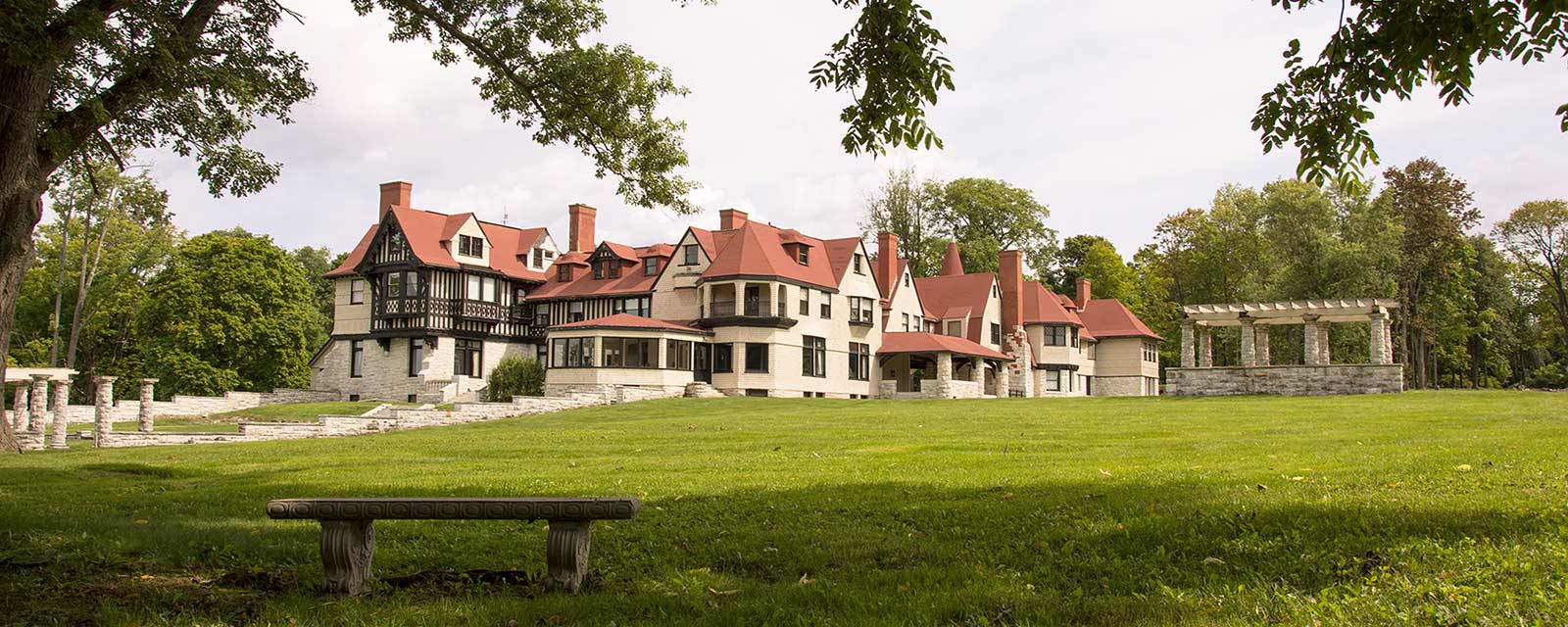
For Sale: Elm Court: 310 Old Stockbridge Road, Lenox, Massachusetts
In school, I was prone to daydreaming, which I guess is not an unusual trait. My daydreams though always involved big rambling houses (maybe more unusual), or the creation of residential units within large rambling structures (warehouses, cathedrals, etc.) My daydreams weren’t just limited to school come to think of it. I remember being at a cousins wedding at this big, beautiful church a few decades ago. Well, the service was really dragging on (as these things often do) and my mind started wandering. By the time they said their “I do’s” I had mentally divided the entire building up into really unique and creative condo units.
Back to the topic at hand – my daydreaming led to sketching – I mean, these were great ideas and needed to be captured. I filled many notebooks with these sketches, elevations, ideas and floor plans of rambling historic structures, rather than the notes, calculus equations or science experiments the books were intended to hold. The more I doodled, the more I started to realize these designs needed to have a purpose – i.e. more of a purpose than houses I could rattle around in and impress my friends. I needed to devise a means to obtain and support these increasingly large structures. The conclusion of course was simple. I simply needed to develop a unique chain of luxury hotels to be housed within these rambling structures. This chain of hotels would target like minded people, who were clearly not satisfied with the type of accommodations provided by a Motel 6 or Ramada Inn. This chain of hotels gave credibility to my daydreams – they finally gained purpose. I still had no financing of course, but I at least had focus. Imagine my delight and surprise when I recently came across a woman by the name of Linda S. Law.
Who is Linda S. Law you ask? She just purchased Elm Court, one of the few remaining Vanderbilt summer homes (yes THOSE Vanderbilts), with a plan to turn it into a luxury resort (yes, I know, I should have patented my unique idea!)
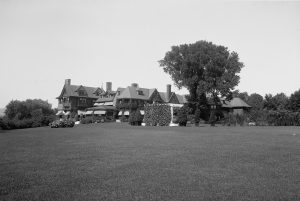 Located at 310-old-stockbridge-road in Lenox, Massachusetts, Elm Court was developed in 1886 as the country estate of William Douglas Sloane and Emily Thorn Vanderbilt, who was the granddaughter of family patriarch Cornelius Vanderbilt. Designed by prominent Boston architects Peabody & Stearns, with landscaping by Frederick Law Olmsted, Elm Court is widely regarded as the largest American Shingle-style home ever constructed in the United States. Like many houses of the era, the level of craftsmanship found in and around the building is rare and the skills required to create it no longer exist – as a result, houses like this can never again be reproduced or replicated.
Located at 310-old-stockbridge-road in Lenox, Massachusetts, Elm Court was developed in 1886 as the country estate of William Douglas Sloane and Emily Thorn Vanderbilt, who was the granddaughter of family patriarch Cornelius Vanderbilt. Designed by prominent Boston architects Peabody & Stearns, with landscaping by Frederick Law Olmsted, Elm Court is widely regarded as the largest American Shingle-style home ever constructed in the United States. Like many houses of the era, the level of craftsmanship found in and around the building is rare and the skills required to create it no longer exist – as a result, houses like this can never again be reproduced or replicated.
The main house offers over 55,000 square feet of ornate living space, contains a reported 106 rooms, including 46 bedrooms and 27 bathrooms and stands prominently on 89 acres of prime New England countryside. The estate features gardener’s and butler’s cottages, a carriage house and stable, an extensive greenhouse complex, and two barns. At it’s peak, a staff of 125 were required to run the house and manicured gardens. One has to remember that in this day and age, remarkably, houses like these were only used for the summer season (the family’s primary house was along millionaires row at 640 Fifth Avenue between 51st Street and 52nd Street in Midtown Manhattan) and were closed and unused for the remainder of the year.
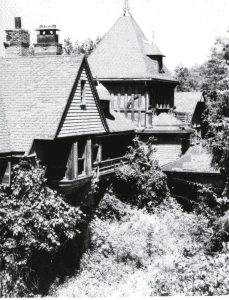 Emily Thorn Vanderbilt died at the house on July 28, 1946, having outlived her first husband, William Douglas (died 1915) and her second, Henry White (died 1927). As you can imagine in 1946 Around that time (World War 2 had ended the prior year) the grand age of the country house had pretty much drawn to a close with finances and staff no longer as available for such an extravigance. In 1948, with limited options for what was deemed a White Elephant, the Vanderbilt-Sloane heirs, unable to find a buyer for the estate re-envisioned Elm Court as an inn: “The Elm Court Club”. After an unsuccessful decade, Elm Court was again closed, boarded up and ultimately abandoned for more than 40 years leaving the once imposing home to the ravages of time, the elements, vandalous teenagers and scavengers.
Emily Thorn Vanderbilt died at the house on July 28, 1946, having outlived her first husband, William Douglas (died 1915) and her second, Henry White (died 1927). As you can imagine in 1946 Around that time (World War 2 had ended the prior year) the grand age of the country house had pretty much drawn to a close with finances and staff no longer as available for such an extravigance. In 1948, with limited options for what was deemed a White Elephant, the Vanderbilt-Sloane heirs, unable to find a buyer for the estate re-envisioned Elm Court as an inn: “The Elm Court Club”. After an unsuccessful decade, Elm Court was again closed, boarded up and ultimately abandoned for more than 40 years leaving the once imposing home to the ravages of time, the elements, vandalous teenagers and scavengers.
In 1999, descendants of the Vanderbilt family, the Berle’s, once again attempted to reclaim the much-deteriorated structure, overhauling, restoring and upgrading the property, with plans to reopen the estate, this time opening as a luxury venue for conferences in 2002.
John Foreman, a passionate architectural historian, hosted a blog called Big Old Houses, posted an amazing article on March 16, 2012, outlining the estate’s history in which he includes many of his own photos of the pre and post renovation efforts of the main house. You can read his post Here
Taking the renovation as far as their resources and energy could go, the Berles placed Elm Court on the market in 2005 for $21.5 million, where it languished for a number of years. In 2012, Elm Court again changed hands, this time for a reported $9.8 million to developer Front Yard LLC, who presented extensive plans to complete the homes renovations and add a large hotel and spa wing which was designed to work with the original Peabody & Stearns architecture. Unsuccessful, Front Yard LLC placed Elm Court back on the market in 2020 for $12.9 million.
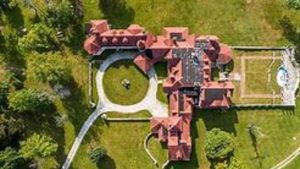 The home again languished on the market, its reputation blighted by exaggerated accounts of neglect, leaking roofs, wood rot, failed structural integrity and exorbitant infrastructure repair requirements just to make the house habitable. In actuality, while elements of the massive structure appeared to be in dire need of renovations, extensive progress had been made by previous owners in what was at one time considered a ruin destined for tear down, this was one of those idyllic situations where a previous owner had already invested and completed all of the “non-glamourous” work (and the work that brings with it the budget killing unforeseen issues which seem to pop up every time a wall is opened up or a pipe is exposed.)
The home again languished on the market, its reputation blighted by exaggerated accounts of neglect, leaking roofs, wood rot, failed structural integrity and exorbitant infrastructure repair requirements just to make the house habitable. In actuality, while elements of the massive structure appeared to be in dire need of renovations, extensive progress had been made by previous owners in what was at one time considered a ruin destined for tear down, this was one of those idyllic situations where a previous owner had already invested and completed all of the “non-glamourous” work (and the work that brings with it the budget killing unforeseen issues which seem to pop up every time a wall is opened up or a pipe is exposed.)
In Dec, 2022, it was reported that Silicon Valley real estate developer Linda S. Law and her partner Dr. Rick Peiser (the head of Harvard University’s real estate program) purchased Elm Court for $8 million. The reputed exorbitant costs associated with saving the house appear to not be the case. Law confirmed in an interview with the New York Post:
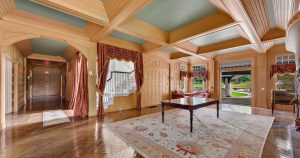 “It was already 75% renovated. People thought it would take $20 million or $30 million to renovate it, but we estimate we’ll spend about $6 million. Only the roof and shingling needs work. The foundation is good; it has sprinklers installed.”
“It was already 75% renovated. People thought it would take $20 million or $30 million to renovate it, but we estimate we’ll spend about $6 million. Only the roof and shingling needs work. The foundation is good; it has sprinklers installed.”
What gives me hope (and envy, if we’re being honest) is that this isn’t Law’s first rodeo, so to speak. She has done this before on a neighbouring Lenox, Massachusetts estate, the 1902, 110-acre Blantyre Estate. Law purchased Blantyre in 2016, for $4.6 million, investing a further $5.1 million into renovations and the reinvention of the estate into a luxury Relais & Chateaux certified luxury hotel.
Although Blantyre had never required the extensive level of improvements and repairs as Elm Court, the estate had also experienced more than its share of owners, vacancies, bankruptcies and long listings. In 1946, a year before Elm Court’s first attempt at operating as a hotel, Blantyre was converted to an inn, but none of the numerous owners were able to make the venture profitable. By the late 1970s, after failed attempts to utilize the property as a movie studio and a college campus, the property was abandoned and mired down with bankruptcy litigations. In 1980 the estate was purchased by the late Jane and Jack Fitzpatrick for $275,000 from The Lenox Savings Bank and embarked on an extensive renovation program, this time successfully operating the estate as a luxury Inn. For more information on Blantyre, their Link is here: www.Blantyre.com
In 2021, having completed an extensive renovation and new establishment of the hotel business, Law listed and sold the estate for $15 million, providing the funds and the resources to purchase Elm Court. This woman was absolutely living my dream!
There once were 73 Gilded Age mansions in the Berkshires area alone, most are now gone.
Additional information and photos of Linda Law and her purchase of Elm Court can be found in the Jan 25, 2023 New York Post article Here